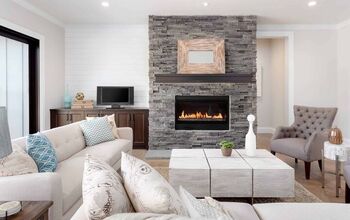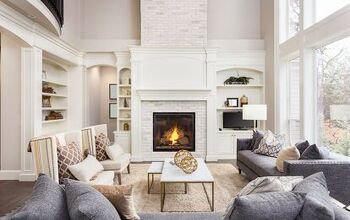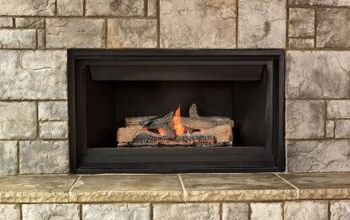Standard Fireplace Mantel Height

If you’re considering building a fireplace in your home, having the right fireplace mantel is crucial. The mantel, or mantelpiece, refers to the flat, horizontal protruding shelf or ledge that sits above the firebox.
A fireplace mantel may be found in one of two forms – as a part of a complete fireplace surround or as a mantel shelf or ‘floating’ mantel. Both types of fireplace mantels often serve as the focal point of a room, which makes it absolutely crucial that you choose the appropriate height.
When it comes to determining the proper fireplace mantel height, it’s crucial that you consider the size of the room. The ideal height also depends on how you intend to use the space above your mantel and the depth of your fireplace.
The average fireplace mantel height is approximately 54 inches, or about 4.5 feet, off of the floor of the hearth. This measurement is from the mantel to the top of the hearth, not to the floor. In most instances, the hearth is slightly raised off of the floor by a couple of inches and the mantel height may differ.
When planning out the perfect fireplace and mantel for your living space, there are a number of factors that you must consider. To help you design the ideal mantel for your home, continue reading and discover everything you need to know about your fireplace mantel.
How High Should a Fireplace Mantel Be?
Like any other home improvement project, one-size-fits-all solutions are few and far between. With so many different styles, aesthetics, layouts, and dimensions, you can’t necessarily follow established universal rules. Instead, you can use best practices in terms of fireplace mantel height.
While the “proper” height of a fireplace mantel is subjective, the standard, or average, mantel height is about 54 inches above the hearth’s floor.
According to national fire codes, a fireplace mantel must be a minimum number of inches higher than the top of the firebox – the flat area of the fireplace. Minimum clearance is determined based on the depth of your fireplace.
The following table outlines some of the most common height requirements for fireplaces in the home:
Fireplace Depth | Minimum Clearance for Mantel Height |
2 inches | 11 inches |
4 inches | 13 inches |
6 inches | 15 inches |
8 inches | 17 inches |
10 inches | 19 inches |
Note: Though these are standard heights for mantels, some manufacturers require a minimum of 12 inches instead of the typical 11 inches for wood-burning fireplaces.
Fireplace Mantel Depth
When it comes to depth, you’ll want to factor in the placement and style of your particular fireplace. While some fireplaces are built into the wall, others stick out or feature a hood that covers the opening.
Regardless, regulations state that your fireplace mantel must stick out a minimum of three inches from the fireplace opening.
This helps absorb the majority of the heat as it rises out of the firebox, while also blocking any sparks that escape from the fireplace.
If your fireplace sticks out from the wall…
You will need to account for additional depth to ensure that the mantel remains three inches out from the wall of the fireplace itself. The key to ensuring that your fireplace sticks out the right amount, you should…
- Plan Ahead
- Take Accurate Measurements
- Consider the Size of Your Room
- Pay Attention to Your Furnishings
A mantel that protrudes too far can result in a tight squeeze between the mantel and other elements of the room. Additionally, the decorations that you intend to place on the mantel may play a role in how far you want it to stick out, as you want to prevent the items from falling off and breaking.
Fireplace Mantel Length
Unlike depth and height, the length of a fireplace mantel doesn’t have any specific regulations, so you have a bit more freedom when designing this aspect of your mantelpiece.
That said, the standard is to add six inches on both sides of your fireplace in order to determine the appropriate length.
For example, if your fireplace measures 36 inches across the top, you’ll want your mantel to be about 48 inches long. Basically, there are two things you should focus on avoiding when determining your mantel’s length:
Don’t Make the Mantel Too Long
If your fireplace has a raised hearth, you may want the mantel and the hearth to have the same length to make everything look symmetrical. A hearth or mantel that is too long can make the entire fireplace look smaller or too short. Not to mention, the mantel will look out of proportion when compared to the fireplace.
Additionally, you don’t want the fireplace mantel to be too long so that it extends from one wall to the other. While this may work for some spaces, a mantel that is too long can actually make both the fireplace and the entire room appear more cramped.
Don’t Make the Mantel Too Short
A short mantel will also look rather odd when combined with a longer fireplace surround and hearth. While an asymmetrical appearance can work well with some interior aesthetics, it often won’t with a short mantelpiece. Plus, you won’t have as much space to place items on it.
How Thick Should a Fireplace Mantel Be?
The thickness of a fireplace mantel describes the distance from the top edge to the bottom edge of the mantel. Much like any other measurements for this project, there isn’t a clear right or wrong answer.
Depending on the material of your mantel, the thickness will be between three and seven inches approximately.
For thinner materials, like wood planks, the mantel only needs to be around three inches thick. Thicker materials like decorative logs, on the other hand, will require a mantel that is between five and seven inches thick.
While this may seem counterintuitive in terms of fire safety, the thinner materials will lose heat faster and the thicker materials will absorb and retain heat more easily.
Bonus Info: Learn about what you can do if your house smells like smoke when using the fireplace.
Overall Fireplace Size
At this point, you’re probably wondering how large a fireplace should be overall. The easy answer is that it’s completely up to you. We’re going to help you out a bit more than that though.
You want your fireplace, including the height of your mantel, to be proportionate to the size of the room it’s in.
A fireplace that’s too large will overwhelm everything else in the space and a fireplace that is too small will look out of place and be lost in the room.
Since mantels are usually anywhere from four to six feet above the floor, a room that is 180 square feet or more should have a mantel that is six feet off the floor. Whereas, a smaller room (120 square feet or less) should have a mantel that is about 4.5 feet above the floor.
If you’re unsure how to size your room for your new fireplace, get in touch with a local contractor to help out.
Lowering A Fireplace Mantel
In most cases, your mantel is already set at the minimum code requirements. Lowering it could infringe on the heat triangulation rules. This basically refers to how close a high heat source can be to different spots of your fireplace without becoming a hazard.
However, if you’ve consulted with the national fire code and they have determined that your mantel is higher than the minimum recommendation, you may be able to lower it. This is a situation where you most definitely need to hire a contractor for the job.
Mounting a TV
It’s true that both your fireplace and your mantel take up a considerable amount of space on your wall. That said, you will still be left with some clearance above the mantel for hanging something else.
Since most ceilings around about nine feet height, you’ll have between 3 and 3.5 feet of space between your mantel and your ceiling. As fireplaces are usually the focal point of a room, mounting a TV is usually the most common way to use the space above a mantel.
Assuming that you’ve installed your mantel correctly, it will block most of the heat that comes from the fireplace. This will protect the TV screen from heat damage. Therefore, if you hang anything on the wall between six and twelve inches above the mantel, it will be out of harm’s way.
However, if you want to further ensure that your TV is safe from the heat, follow these tips:
- Test the temperature of the wall before you mount the TV. If it is 100 degrees Fahrenheit or higher, you should not mount the TV directly against the wall.
- Mount your TV at least 12 inches above the mantel if your mantel is less than four feet off of the floor.
- Tilt the TV slightly downward for a clearer viewing angle since it will be higher on the wall.
Instead of mounting a TV, you can choose to install a bookshelf, display family photos, or hang artwork instead.
What Should a Fireplace Mantel Be Made Out Of?
Your mantelpiece is more than an aesthetic feature in your home. Its other purpose is to absorb the heat that rises from the fireplace, preventing the wall above from overheating. That said, you should choose durable and safe materials. Some common mantel materials include:
- Glass
- Stone
- Concrete
- Wood
- Metal
- Brick
- Tile
- Limestone
Note: Practice precise care when you paint or repair your mantel to avoid any materials that may be combustible.
Related Question
If you have a newer fireplace, the wall above it is likely drywall over standard wood studs or furring strips. Studs are typically made using 2×4’s, but furring strips are usually only about an inch wide. Regardless, drywall and wood supports will make mounting a TV over your fireplace a much smoother process.
Final Thoughts About Your Mantelpiece
There are many different types of fireplaces and mantels from which you can choose for your home. This can make it difficult to know where to begin as you dive into the remodeling process. Hopefully, this article has helped start you on the right path. Here’s a quick summary before you go.
As far as height g0es, you should leave approximately 54 inches of space between the mantel and the hearth’s floor. Other measurements will be dependent on the length and depth of your fireplace, the hearth, and the surround.
Related Articles

Jessica considers herself a home improvement and design enthusiast. She grew up surrounded by constant home improvement projects and owes most of what she knows to helping her dad renovate her childhood home. Being a Los Angeles resident, Jessica spends a lot of her time looking for her next DIY project and sharing her love for home design.
More by Jessica Stone






















![12 Washing Machine Brands to Avoid [with Recall Data]](https://cdn-fastly.upgradedhome.com/media/2023/07/31/9075781/12-washing-machine-brands-to-avoid-with-recall-data.jpg?size=350x220)





